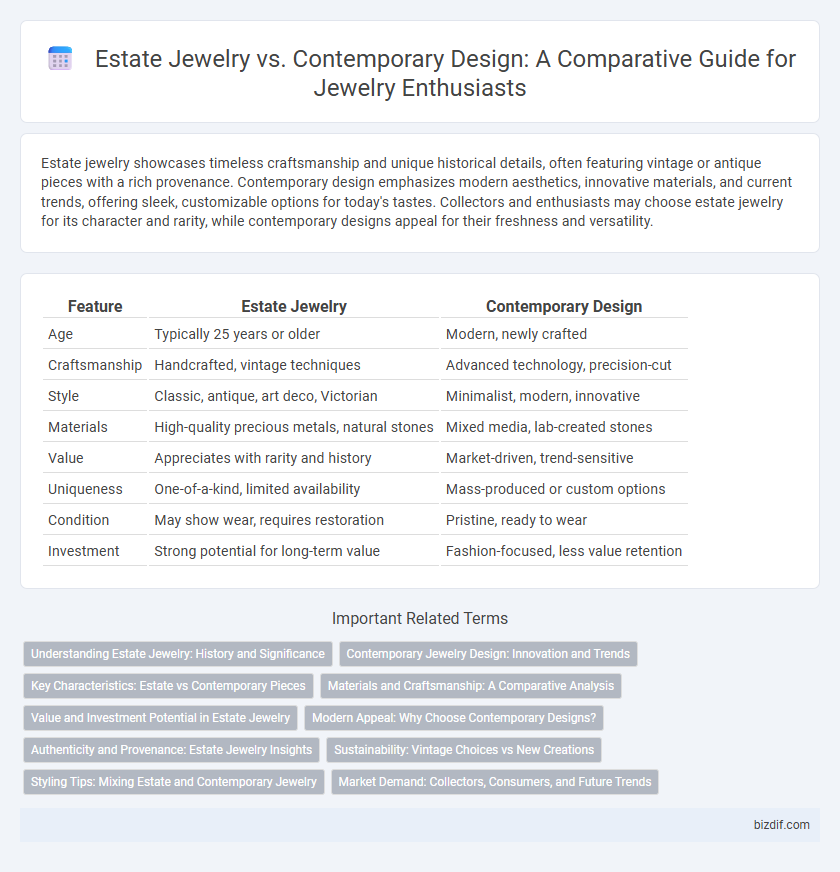Estate jewelry showcases timeless craftsmanship and unique historical details, often featuring vintage or antique pieces with a rich provenance. Contemporary design emphasizes modern aesthetics, innovative materials, and current trends, offering sleek, customizable options for today's tastes. Collectors and enthusiasts may choose estate jewelry for its character and rarity, while contemporary designs appeal for their freshness and versatility.
Table of Comparison
| Feature | Estate Jewelry | Contemporary Design |
|---|---|---|
| Age | Typically 25 years or older | Modern, newly crafted |
| Craftsmanship | Handcrafted, vintage techniques | Advanced technology, precision-cut |
| Style | Classic, antique, art deco, Victorian | Minimalist, modern, innovative |
| Materials | High-quality precious metals, natural stones | Mixed media, lab-created stones |
| Value | Appreciates with rarity and history | Market-driven, trend-sensitive |
| Uniqueness | One-of-a-kind, limited availability | Mass-produced or custom options |
| Condition | May show wear, requires restoration | Pristine, ready to wear |
| Investment | Strong potential for long-term value | Fashion-focused, less value retention |
Understanding Estate Jewelry: History and Significance
Estate jewelry embodies rich historical significance, often crafted from the 19th to mid-20th century, showcasing distinct design eras such as Victorian, Art Deco, and Retro. These pieces carry unique provenance and artisanal techniques that highlight craftsmanship and cultural trends of their time. Collectors and enthusiasts value estate jewelry for its authenticity, rarity, and connection to historical narratives within the jewelry-making tradition.
Contemporary Jewelry Design: Innovation and Trends
Contemporary jewelry design emphasizes innovative techniques and materials, integrating technology such as 3D printing and sustainable sourcing to create unique, modern pieces. Current trends highlight minimalist aesthetics, geometric shapes, and customizable elements that reflect individual style and cultural influences. Designers often blend traditional craftsmanship with digital tools to push boundaries and redefine luxury in the jewelry market.
Key Characteristics: Estate vs Contemporary Pieces
Estate jewelry features vintage or antique pieces often crafted with intricate handwork, unique gemstones, and timeless designs reflecting historical eras. Contemporary jewelry emphasizes modern aesthetics, innovative techniques, and sleek materials like titanium or mixed metals, appealing to current fashion trends. Key distinctions include the provenance and craftsmanship of estate pieces versus the cutting-edge styles and often experimental nature of contemporary designs.
Materials and Craftsmanship: A Comparative Analysis
Estate jewelry often features materials like platinum, yellow gold, and natural gemstones, reflecting the meticulous handcraftsmanship and intricate detailing of past eras. Contemporary design emphasizes innovative materials such as titanium, resin, and lab-grown diamonds, showcasing modern techniques like 3D printing and precision casting. The contrast between estate and contemporary jewelry highlights evolving preferences in material durability and artisanal skill sets over time.
Value and Investment Potential in Estate Jewelry
Estate jewelry often holds higher value and investment potential due to its historical significance, rare craftsmanship, and unique designs that are no longer produced. Unlike contemporary design pieces, estate jewelry's provenance and vintage appeal attract collectors and investors seeking tangible assets with the possibility of appreciation over time. The scarcity and enduring allure of estate jewelry make it a strategic choice for those prioritizing long-term value in their collections.
Modern Appeal: Why Choose Contemporary Designs?
Contemporary jewelry designs offer a fresh, innovative aesthetic that incorporates the latest trends, materials, and techniques, making them ideal for those seeking a modern appeal. Unlike estate jewelry, which carries historical and vintage charm, contemporary pieces emphasize clean lines, unique shapes, and customizable options to reflect personal style. Choosing contemporary designs ensures access to cutting-edge craftsmanship and versatile pieces suited for everyday wear or special occasions.
Authenticity and Provenance: Estate Jewelry Insights
Estate jewelry boasts verifiable provenance and authentic craftsmanship from specific historical periods, elevating its value and uniqueness. Contemporary design emphasizes modern techniques and innovation, often lacking the deep historical context found in estate pieces. Collectors and enthusiasts prioritize estate jewelry for its documented authenticity and rich story, which contemporary designs may not provide.
Sustainability: Vintage Choices vs New Creations
Estate jewelry embodies sustainable luxury by repurposing vintage pieces that reduce demand for new mining and manufacturing processes, preserving precious metals and gemstones. Contemporary designs increasingly incorporate recycled materials and ethically sourced gems, reflecting a growing industry commitment to sustainability and environmental responsibility. Choosing estate jewelry or eco-conscious new creations both contribute to minimizing the ecological footprint of jewelry consumption.
Styling Tips: Mixing Estate and Contemporary Jewelry
Mixing estate jewelry with contemporary design creates a unique, personalized look by combining vintage charm and modern trends. Pairing bold, antique statement pieces with sleek, minimalist contemporary items enhances contrast while balancing proportions and textures. Layering different metal tones, like yellow gold estate rings with white gold contemporary bracelets, adds visual interest and showcases individuality in jewelry styling.
Market Demand: Collectors, Consumers, and Future Trends
Estate jewelry attracts collectors seeking unique craftsmanship and historical value, driving strong demand in vintage markets. Contemporary design appeals to modern consumers with innovative styles and customizable options, reflecting current fashion trends. Future market trends suggest a blend of ethical sourcing and technology integration will shape both estate and contemporary jewelry demand.
Estate Jewelry vs Contemporary Design Infographic

 bizdif.com
bizdif.com